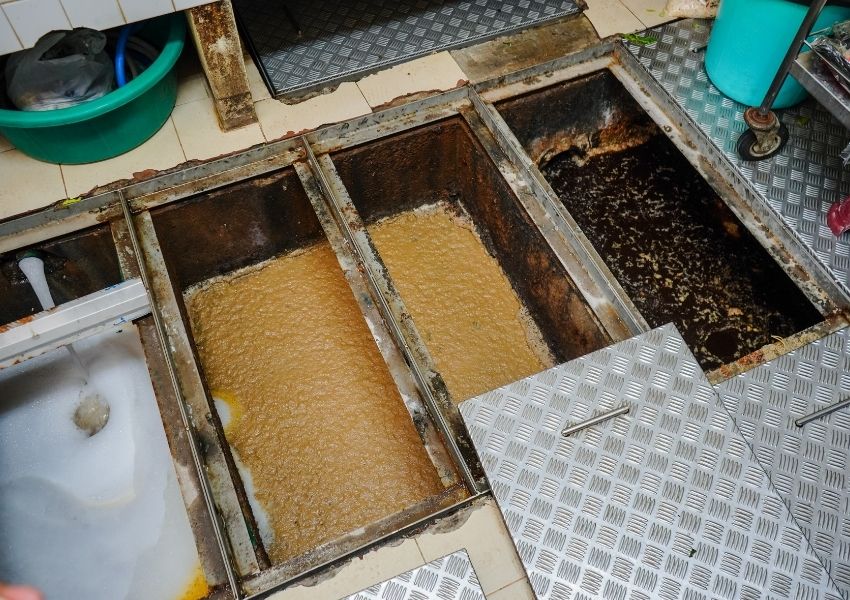Having a grease trap is a necessity for any restaurant. Fats, oils, and grease (FOG) can accumulate quickly once it cools in the pipes. This leads to major pipe blockages that can even affect the surrounding area’s sewer system. By having a grease trap, you’ll save yourself from a major headache, to say the least.
Not sure what’s involved in having a grease trap? No worries! Greasecycle, the top grease trap cleaning service provider in Raleigh, has provided the following guide to help answer the most common questions.
How Do Grease Traps Function?
Drains in your kitchen usually run through a grease trap. In short, the grease trap is a tank that serves as a separator for oils and grease in the wastewater. This wastewater can come from dishwashers, sinks, and even floor drains. In the grease trap, the FOG rises to the top of the water and is removed while the rest is drained through another pipe into the sewer system.
Why Is a Grease Trap Necessary?
As previously mentioned, commercial kitchens that generate FOG are required to have a grease trap to avoid blocking the local sewer system. It also prevents contamination of the water. This is a requirement, the details of which depend on the local, state, and federal laws in the area.

To elaborate, FOG that enters the sewer system sticks like glue around the sides of the pipes. At a certain point, it will block the passage of water, causing a backup in the pipes that enter the sewer system and drains from your restaurant. Aside from wastewater backing up into your kitchen, severe cases can cause water to overflow from sewer outlets and manholes into the streets and waterways.
Does My Grease Trap Need to Be Inspected?
Yes, this is a requirement of having a fully-functional grease trap. It should be inspected every 1-3 months, and thoroughly cleaned to avoid buildup. Using a professional grease trap service provider like Greasecycle means having a schedule in place for preventative maintenance.
As a restaurant owner, you are responsible for ensuring that the grease is properly handled and that the grease trap is cleaned and maintained regularly. Part of the proper handling of grease is through its disposal. Some grease trap service providers may not dispose of the grease legally, so make sure you hire a reliable company like Greasecycle for the grease disposal.
How Is a Grease Trap Maintained?
Having your grease trap routinely serviced is key to having it remain functional. Overflows can be avoided and any damage that’s found can be repaired quickly before it spirals into a bigger and more costly issue. Be sure that this maintenance is on a routine schedule.

For example, a common issue you may run into is that the grease trap releases an odor. This is a sign that the lid’s gasket may need replacing.
Additionally, your employees should be educated on how to handle FOG. Doing this will greatly reduce the risk of damage to your grease trap and overall sewer system. It’s also worth having a drain cover.
How Do You Clean a Grease Trap?
Cleaning a grease trap is not a DIY endeavor. There are various methods that are mandated by the local area. A professional grease trap cleaner like Greasecycle means hiring someone who is fully versed in any new local regulations involved in handling the cleaning process.
The method of cleaning, keeping records, and disposing of the grease all have strict policies with hefty fines should they not be followed.
You are always responsible for the FOG that’s removed from your grease trap. It does not matter whether it’s off your property or not when it comes from your establishment. As mentioned, hiring a reputable professional is the best option.
Is It Okay That My Grease Trap Is Full of Water?
No, this is not a good sign. If your grease trap is full of water, an overflow could happen, contaminating the local sewer system. In general, grease traps should be ¼ full of water.
With a Grease Trap, Can I Pour Grease Down the Drain?
You should never empty the excess grease directly down the drain. Having a grease trap is not an excuse for pouring anything into the sink. Grease solidifies as it travels through the pipes, causing blockages.

Grease traps are meant for residual grease, not for the removal of solid FOG. It’s best to collect your cooking oil and have it properly recycled, which is another service Greasecycle is happy to provide.
What Is the Best Size for a Grease Trap?
There is no one-size-fits-all solution for grease traps. It depends on your business. More specifically, the size is determined by how much grease is produced by your establishment. In some cases, the size of grease traps is regulated in certain areas. However, consulting with an expert in grease traps is usually done to find the best size for your commercial kitchen.
Bottom Line
Having a grease trap isn’t optional, and it also isn’t something you can just install and forget about. Grease traps need regular cleaning and maintenance. If you’re looking for help with your grease trap, turn to no other than Greasecycle! We’re experts in all things grease-related.
We offer a wide range of services relating to the care of grease traps. From grease trap pumping and cleaning, oil recycling, grease trap waste processing, preventative drain jetting, to bulk oil purchasing, we have you covered! Contact us today to learn how we can best help your grease trap operate smoothly for years to come.